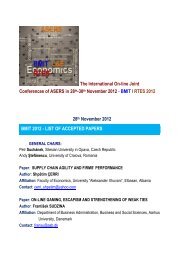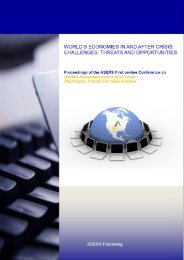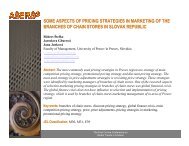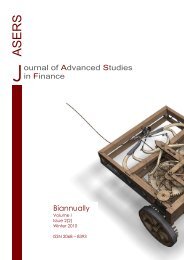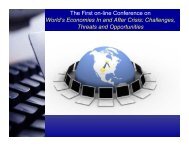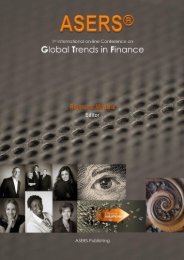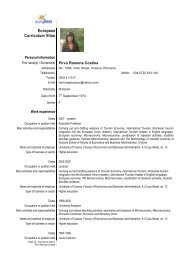Can Shift to a Funded Pension System Affect - ASERS
Can Shift to a Funded Pension System Affect - ASERS
Can Shift to a Funded Pension System Affect - ASERS
You also want an ePaper? Increase the reach of your titles
YUMPU automatically turns print PDFs into web optimized ePapers that Google loves.
Theoretical and Practical Research in Economic Fields<br />
Trade in tasks and the fragmentation of production along global supply chains has challenged<br />
the validity of the traditional models, based on the exchange of final goods. As for trade in intermediate<br />
goods, two main approaches have been explored. The first one rests on the hypothesis that fac<strong>to</strong>rs<br />
(capital and labour) are fixed. Offshoring is similar <strong>to</strong> technical progress in the production of the final<br />
good: by shifting production processes <strong>to</strong> the countries with comparative advantages, more of the final<br />
goods can be produced with the same (fixed) amount of fac<strong>to</strong>rs. A firm with better technology at home<br />
wills offshore some tasks if the initial wage gap is larger than the offshoring costs. Offshoring releases<br />
domestic workers who, under the traditional neo-classical market assumptions, can focus on the tasks<br />
where they have a trade-cost-adjusted comparative advantage.<br />
When some fac<strong>to</strong>rs are mobile sec<strong>to</strong>rally and internationally, the law of comparative advantage<br />
can be generalized, albeit analyzing the outcome of even simple normative models becomes a complex<br />
matter, particularly regarding the distributional effects. Comparative advantages are no more a robust<br />
predic<strong>to</strong>r of a country‟s trade pattern. For example, reversal of comparative advantages is possible<br />
under certain assumptions. When fac<strong>to</strong>rs are mobile, movement of fac<strong>to</strong>rs between sec<strong>to</strong>rs and<br />
between countries that tend <strong>to</strong> equalize endowments reduce the incentives <strong>to</strong> trade. The return of the<br />
mobile fac<strong>to</strong>r rises, while those of <strong>to</strong> sec<strong>to</strong>r-specific fac<strong>to</strong>rs decline. But if fac<strong>to</strong>r prices are not equalized,<br />
fac<strong>to</strong>r mobility will at contrary lead <strong>to</strong> an increase in the volume of trade.<br />
The new trade theory, by introducing imperfect competition, consumer preference for variety and<br />
economies of scale, look at explaining why countries that are similar in fac<strong>to</strong>r endowment and<br />
technology, have a significant part of their trade in the same industries. When two such identical<br />
countries open up <strong>to</strong> trade, firms with differentiated products gain access <strong>to</strong> larger markets and offer<br />
more choice <strong>to</strong> consumers. While consumers face a greater choice of products, product differentiation<br />
imparts firms with a degree of market power. But the entry of new firms modifies the way consumers<br />
substitute between products as prices and product offerings change, and reduce the market power of<br />
the firm. In addition, the <strong>to</strong>tal size of the market does not increase, and some firms will go out of<br />
business.<br />
A similar pattern can be used <strong>to</strong> model trade in intermediate goods, provided the cost of<br />
production is lower the larger is the number and scale of production of intermediates. If trade is<br />
restricted, the domestic firm needs <strong>to</strong> use outsourcing <strong>to</strong> realize these economies of scale and choice.<br />
For example, firms (and governments) may solicit bids <strong>to</strong> supply goods or services in context of<br />
information asymmetry and imperfect competition. If international trade is free, it does not matter<br />
anymore where the production of intermediaries is located (besides the additional transaction costs),<br />
and the firm producing the final good uses a mix of outsourcing and offshoring. Even in presence of free<br />
trade, it is expected that monopolistic behaviour tend <strong>to</strong> predominate, as organized supply chains<br />
(business groups) exercise market power in their sales of intermediate inputs. Feenstra and Hamis<strong>to</strong>n<br />
(2006) relate that firms belonging <strong>to</strong> such groups treated their member firms preferentially, buying and<br />
selling at prices different than those used for non-member firms.<br />
The real circuit: The industrial supply side aspects and the transmission of real shocks across sec<strong>to</strong>rs<br />
and countries is modelled by E-G09 using an international input-output matrix (a set of interlinked national I-O<br />
matrices), rearranged <strong>to</strong> track forward linkages. 22 E-G09 computes an indica<strong>to</strong>r, called “imported real supplydriven<br />
impact coefficient” (IRSIC), defined in the price space <strong>to</strong> simulate cost-push due <strong>to</strong> intermediate inputs:<br />
IRSIC = ΔQ(I-B) -1 ● 1/Q (1)<br />
where, for “n” countries and “s” sec<strong>to</strong>rs; Q: line vec<strong>to</strong>r of initial sec<strong>to</strong>ral output (1 x n.s), B : matrix of [b ij ] allocation<br />
coefficients (n.s x n.s) 23 , (I-B) -1 : Ghosh-inverse matrix, i.e. the sum of direct and indirect forward effects, ΔQ: line<br />
vec<strong>to</strong>r of supply shocks (initial increases in sec<strong>to</strong>ral production costs emanating from the shock-exporter country)<br />
(1 x n.s), and ● 1/Q : Hadomard (entry wise) product.<br />
22 In an international IO matrix (I-IO), cross-national transactions of intermediate goods are identified: exports of<br />
intermediate consumption are separated from final demand and traced <strong>to</strong> the importing country and sec<strong>to</strong>r. This provides a<br />
better definition of vertical network participation of the countries included in the I-IO, allowing tracking shock transmission<br />
caused by vertical integration.<br />
23 In a supply-use table, inter-sec<strong>to</strong>ral relationships are represented by the coefficients Qij, with the use of goods and<br />
services <strong>to</strong> supply other firms, final consumers and rest of the world (exports) on horizontal lines and requirements<br />
(purchases from domestic and foreign suppliers; primary inputs or value added) in columns. The technical coefficients used<br />
by the Leontief matrix represents interindustry sales by sec<strong>to</strong>r i and are derived by normalizing the intermediate coefficients<br />
Qij by the value of <strong>to</strong>tal production (aij= Qij/Qj). The Ghosh matrix B also is build using supply-use table, but the allocation<br />
coefficients represent now the purchase by j of interindustry inputs from i (bij= Qij/Qi).<br />
30



